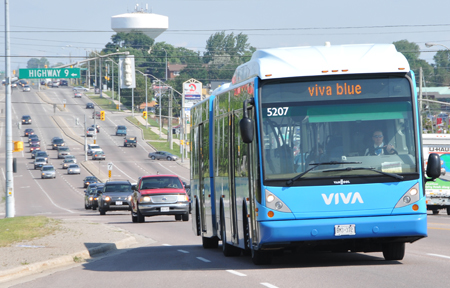
I often talk about the big picture benefits of the vivaNext plan; our rapid transit system will help York Region manage growth through new transit-oriented development; reduced reliance on cars will benefit the environment; greater choice will improve the quality of life for York Region residents. And of course, the main benefit of the vivaNext plan— rapidways will allow people to get around York Region faster than before.
The vivaNext rapidways are going to make a major difference to the timeliness and efficiency of Viva service, but what you may not know is, we took steps prior to Viva’s launch to make the service as fast as was possible. We put various measures into place – collectively called “transit priority measures” – to make it easier for Viva vehicles to get through gridlock. This means that commuters on Viva are already able to cut through traffic congestion faster than people travelling in cars.
Ok, I know what you’re thinking: “There’s no way a bus can go faster than a car unless it’s in its own lane.” Allow me to explain.
In general, transit priority measures are strategies that help buses move quickly along their routes. These measures can involve physical improvements to the roadway, with the most obvious example being dedicated lanes through congested areas (like the vivaNext rapidways!). A less dramatic, but still effective approach is that of queue-jumping lanes, which allow buses to move ahead of congested traffic at intersections. We installed queue-jumping lanes for Viva’s first phase.
Another transit priority measure involves legislative steps. Have you ever noticed the big “Yield to Bus” sign on the back of buses? This transit priority measure was added to Ontario’s Highway Traffic Act to improve transit flow and make transit service more reliable and efficient. This law actually requires drivers to yield the right-of-way to buses trying to leave bus bays and merge with traffic.
The other key category of transit priority measures involves something called “intelligent transportation systems” which are signal system technologies used to improve transit efficiency. Signal systems are quite complex, but in general, modern signals analyze inputs (e.g. vehicles approaching a signal or crossing buttons being pushed by pedestrians) and decide when the traffic lights should change. Transit priority systems add another important input. A bus will automatically send a message to the traffic signal telling it to change, and the signal will adjust its timing in response, favouring the bus. This is not to say that the bus is guaranteed a green light (such as the case of an emergency vehicle), but rather that the delay to the transit vehicle is slightly reduced compared to normal operation (without the transit signal priority).
Viva vehicles don’t “ask” for priority at every signal; priority is only requested when the Viva vehicle is running behind schedule. Currently, Viva vehicles can ask for a low level of priority when they are one minute off schedule, and more immediate priority when they are three minutes behind schedule. And to provide some context, with light cycles in the Region often lasting about two minutes, missing one light can easily put a bus behind schedule. So signal priority is an important tool that helps keep the system running on time, even during the busiest times of the day.
By combining dedicated transit lanes through the most congested parts of Highway 7, Yonge Street and Davis Drive with other transit priority measures in less crowded stretches, Viva is going to offer you a ride that will be comfortable, convenient, fun—and faster than ever before.
